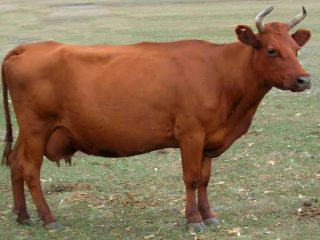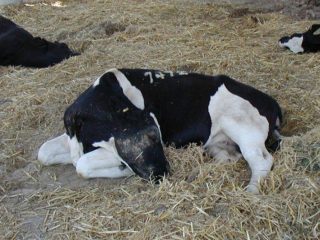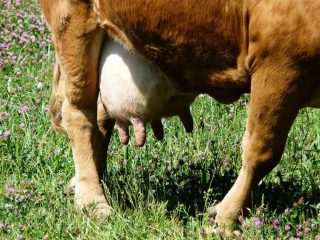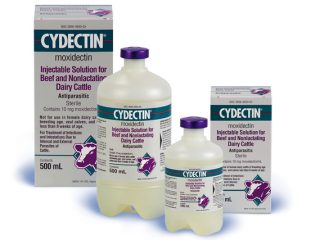Content
Cattle brucellosis is a disease that can lead to the complete ruin of a farm "out of the blue". The insidiousness of brucellosis is that animals are well adapted to brucella and get sick without visible signs of disease. Due to the external welfare of animals, cattle owners often suspect veterinarians of collusion with large agricultural complexes or meat processing plants. But brucellosis is too dangerous to be able to engage in amateur activities, ignoring veterinary requirements.
What is brucellosis
A chronic bacterial disease that affects both animals and humans. In animals, brucellosis causes 6 types of bacteria. It appears:
- detention of the placenta;
- abortion;
- infertility;
- orchitis;
- the birth of unviable cubs.
Each species is specific to its host. Man is universal: he is capable of contracting brucellosis caused by any kind of bacteria. Because of this, brucellosis is included in the list of quarantine diseases.
Causes of occurrence and transmission routes
Morphologically, all types of brucella are the same: immobile small bacteria that do not form spores. The size of the causative agents of brucellosis is 0.3-0.5x0.6-2.5 microns. Gram-negative.
Resistance to environmental influences:
- manure, soil, roughage, water - up to 4 months;
- direct sunlight - 3-4 hours;
- heating up to 100 ° С - instantly;
- disinfectants - 1 group.
With such a weak stability, immobility and lack of reproduction through spores, brucella should have died out by themselves. But they continue to thrive.
The secret to the vitality of bacteria is that brucellosis is usually asymptomatic. The pathogen is released into the external environment along with physiological fluids. In cattle, brucellosis is often transmitted to the calf through milk. In 70% of cases, a person becomes infected with brucellosis from cattle, using unboiled milk.
Clinical picture
With the standard course of brucellosis, there is no clinical picture in cattle. There are only miscarriages at 5-8 months of pregnancy. This symptom is the reason that the discarded fetus cannot simply be buried in the garden, but must be submitted for examination to establish the causes of the abortion.
The video shows well how difficult it is to convince the cow owner of the animal's disease:
But the asymptomatic course of brucellosis in a cow does not mean that a person will endure it without problems. The cow cannot tell where it hurts. Cattle do not have sweat glands and are unable to perspire. But people who have contracted brucellosis indicate a not entirely asymptomatic course of this disease:
- joint pain, sometimes very severe;
- prolonged or wave-like increase in temperature by 1 ° C against the usual;
- heavy sweating;
- prostration.
In cattle, if these symptoms are present, they are usually not noticeable. Animals try to hide the pain and weakness until it gets really bad. The weakened animal is eaten by predators, but everyone wants to live. In cattle, a decrease in milk yield is also observed, but this can also be attributed to a lot of other reasons.
Damage to the body
Brucellosis affects all systems of the body, but this is expressed not in specific symptoms, but in the appearance of other diseases, from which they begin to treat the cow.
With the defeat of the musculoskeletal system, various types of arthritis, osteomyelitis, myalgia develop. From heart diseases can manifest:
- thrombophlebitis;
- endocarditis;
- aortic abscess;
- pericarditis;
- myocarditis.
Heart disease in humans is often detected only as a result of examination. Since cattle is never fully examined, these pathologies with brucellosis go unnoticed. The cow became a little smaller and moved a little slower. This is hardly noticeable in the herd. Myositis will also be attributed to muscle chilling on the cold floor or ground.
With the defeat of the respiratory system, pneumonia and bronchitis develop. Also, few people associate these diseases with brucellosis. Developed hepatitis is also unlikely to be associated with Brucella. And with general exhaustion and the absence of other problems, they first of all remember about worms.
Brucellosis can complicate the kidneys, but acute pyelonephritis can be attributed to the common cold.
Symptoms of encephalitis will be attributed to tick bite infection. Eye diseases are indeed more likely to occur for other reasons, but may also be due to brucellosis. I don't want to believe in bad things, so the owner will treat the symptoms, not the disease.
Forms of flow
There are 5 forms of brucellosis:
- primary latent;
- acute septic;
- primary chronic metastatic;
- secondary chronic metastatic;
- secondary latent.
Symptoms are well expressed only with acute septic. With primary latent, which proceeds without clinical signs, even a person feels completely healthy. It is possible to recognize a cow infected with brucellosis with this form only after laboratory blood tests.
With a weakening of immunity, the primary latent form becomes acutely septic, which is characterized by fever. The rest of the animal is doing well. But by the end of the first week, the liver and spleen are enlarged.
Chronic forms can develop immediately from the primary latent or some time after acute septic. The clinical manifestations of both metastatic forms are the same. The difference between them is the presence of an acute septic phase in the anamnesis. In chronic forms, ODA damage, enlargement of the liver and spleen, and general weakness become noticeable. Joint diseases develop and muscle pains appear.
Diagnostics
Brucellosis is reliably determined only by laboratory methods. The study for brucellosis of cattle is carried out by two methods: serological and allergic. When serological, the diagnosis is established in several ways:
- test tube agglutination reaction (RA);
- complement fixation reaction (PCR);
- lamellar agglutination reaction with rose bengal antigen - rose bengal test (RBP);
- long-term complement binding reaction (RDSK);
- ring reaction with milk (CR).
If necessary, re-test for brucellosis is carried out. With the serological method, the interval between analyzes is 15-30 days, with the allergic method - 25-30 days.
If cattle were vaccinated against brucellosis, then the tests are done within the time specified in the instructions for the vaccine.
Abortion with suspected brucellosis
If abortions have occurred in a herd of cattle recognized as healthy for this disease, the expelled fetuses are sent to a laboratory for bacteriological examination. Abortion could have occurred due to other diseases, so it is imperative to exclude brucellosis.
There is a certain order in the diagnosis of the disease:
- either the whole fetus or part of it (stomach) is sent for a bacteriological test to the veterinary laboratory;
- at the same time, cattle blood from an aborted herd is sent for serology.
When a culture of brucellosis bacteria is isolated or a positive test for serology, the diagnosis is considered established.
If the bacteria were not isolated, and the blood showed a negative result, a second serological test is performed 15-20 days later. If all tests are negative, the herd is considered healthy for brucellosis.
If positive results are obtained during serological testing of suspicious cows, a second blood test is performed after 2-3 weeks. The rest of the herd is being investigated in parallel. If no other animals with a positive reaction are found, the herd is considered safe.
In the presence of cattle with a positive reaction, in addition to those who were initially suspected, the herd is recognized as dysfunctional, and positively reacting cows are sick and measures are taken to improve the herd's health.
If individuals with a positive reaction to brucellosis are found in a previously prosperous farm, suspicious cattle are isolated and a blood test is carried out. At the same time, tests are taken from the rest of the cattle. If there is a positive reaction in suspicious cows or conventionally healthy animals, the herd is considered unfavorable. If a negative result is obtained during a serological study and there are no signs indicating brucellosis, cows that have reacted to the allergen are sent to slaughter.
In cattle herds, unfavorable for brucellosis, such subtleties no longer go into such subtleties. If the cow responds positively to the tests, she is slaughtered.
Therapies
Since brucellosis of cows is included in the list of diseases dangerous to humans, no therapy for infected animals is carried out. After double confirmation of a positive reaction to brucellosis, sick animals are sent to slaughter. The meat is suitable for making cooked sausages.
It is possible, but not necessary, to try to cure brucellosis in cattle with antibiotics. The drugs take effect only on the third day. All this time, the cow abundantly strews the surrounding area with brucella. Since bacteria persist in dirt and manure for a long time, after recovering, the animal will fall ill again.
The only type of "therapy" allowed for brucellosis in cattle is herd health. The term means that all cows that showed a positive reaction are destroyed. After the quarantine has been lifted, healthy animals are introduced into the remaining herd.
Forecast
The prognosis is unfavorable for 100% of sick cows. The life of these individuals ends in a slaughterhouse. To prevent brucellosis diseases, only preventive measures are possible.
Prophylaxis
Prophylaxis is carried out in accordance with official veterinary instructions. The level of preventive measures depends on the contamination of the area and the economy. The main measures to prevent the spread of brucellosis:
- constant veterinary control;
- observance of the sanitary rules for keeping cattle;
- a ban on the movement of livestock from disadvantaged areas to safe ones;
- the presence of a veterinary certificate for an animal reintroduced into the herd;
- in brucellosis-free areas, it is forbidden to move livestock from one farm to another, as well as inside the farm, without the permission of a veterinarian;
- quarantine of newly arrived animals for a period of 30 days. During this time, a study is carried out for brucellosis;
- when sick animals are detected in quarantine cattle, the entire new group is slaughtered;
- do not allow contact of cattle from dysfunctional and "healthy" farms;
- during abortions, the fetus is sent for research, the cow is isolated until a diagnosis is made.
The plans for diagnostic measures are approved annually by the veterinary services.
In prosperous areas, livestock surveys are carried out once a year. In dysfunctional ones - 2 times a year. Also, 2 times a year, cattle are examined at distant-pasture cattle breeding and on farms located on the border with a disadvantaged area.
Vaccination
Vaccinations are carried out by an employee of the state veterinary service. Live vaccine is used against brucellosis in cattle. Subject to the rules, the shelf life of the vaccine is 1 year. After the expiration of the storage period, it is not suitable for use.
Release form - bottle. Once opened, the vaccine must be used within 4 hours. The unused drug is disinfected and destroyed. The capacity of the bottle can be 2, 3, 4, 8 ml. The vaccine package contains instructions for its use.
Danger to humans and precautions
Since brucellosis is often almost asymptomatic, it manages to cause harm before a person realizes that it is infected. Bronchitis and pneumonia can be cured, but changes in the joints and central nervous system are already irreversible. Brucellosis is not dangerous in itself, but because of the complications it causes.
The precautions are simple:
- vaccinate animals on time;
- do not buy dairy products from hands in places not specified for trade;
- raw milk must be boiled.
In urban dwellers, infection with brucellosis occurs with the use of "home" milk and young cheese. In the village, a person can also become infected by removing manure.
Workers of the cattle farm are provided with overalls and footwear. The farm should be equipped with a room where the worker can take a shower. There should be a storage room for workwear and first aid kits. Be sure to carry out periodic medical examination of working personnel on the farm.
Conclusion
Brucellosis of cattle, being a quarantine and one of the most dangerous diseases, requires respect for itself. People are easily infected with it. Since there are no symptoms for the first time, it is often too late to treat when symptoms appear. For this reason, strict adherence to measures to prevent brucellosis and mandatory vaccination are necessary.














